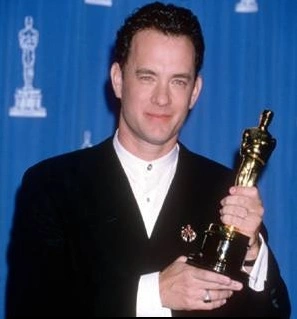Tom Hanks Tom Hanks, born in 1956, American motion-picture actor, a two-time Academy Award winner who is acclaimed for both his comic and dramatic performances.
Publié le 12/05/2013

Extrait du document

Tom Hanks Tom Hanks, born in 1956, American motion-picture actor, a two-time Academy Award winner who is acclaimed for both his comic and dramatic performances. Born in Concord, California, Hanks attended California State University, Sacramento, from 1976 to 1977. He then acted in regional theater in Ohio and California for the next three years. From 1980 to 1982 he costarred in the television program Bosom Buddies, a comedy series about two men who pass as women to live in an inexpensive hotel for women residents only. Hanks's first major motion-picture role was in Splash (1984), a romantic comedy in which he plays a man who falls in love with a mermaid. In the comedy Big (1988), Hanks portrays a 12-year-old boy who magically takes on the size and appearance of an adult overnight. In the late 1980s and early 1990s Hanks appeared mostly in light or comedic roles in motion pictures such as Dragnet (1987), Punchline (1988), The 'Burbs (1989), Turner & Hooch (1989), The Bonfire of the Vanities (1990), Joe Versus the Volcano (1990), and A League of Their Own (1992). In 1993 he demonstrated a broader range of acting ability, costarring with Meg Ryan in the romantic comedy Sleepless in Seattle, about a widowed man who falls in love, and in the drama Philadelphia as a gay lawyer with acquired immunodeficiency syndrome (AIDS) who sues his employer after being fired. The latter role won him the 1994 Academy Award for best actor. Hanks gained further popularity and critical praise as the intellectually challenged but accidentally successful title character in Forrest Gump (1994). For this performance Hanks won the 1995 Academy Award for best actor, becoming the first performer since Spencer Tracy to win the award in two consecutive years. Later films include Apollo 13 (1995), in which Hanks plays an astronaut on a doomed mission, and Toy Story (1995), a computer-animated film in which he provides the voice of Woody, a cowboy doll. In 1996 Hanks made his directorial debut with That Thing You Do!, for which he also wrote the screenplay. The film follows the rise and fall of a "one-hit wonder" band in the 1960s. In 1998 Hanks cowrote and codirected the television miniseries "From the Earth to the Moon," chronicling the American efforts to send astronauts to the moon. Hanks returned to acting in Steven Spielberg's World War II (1939-1945) drama Saving Private Ryan (1998), playing the leader of a mission to find a young soldier whose brothers have been killed in action. He received a best actor Academy Award nomination for the role. In You've Got Mail (1998), he and Ryan teamed up again in a romantic comedy about two people who dislike each other in person but fall in love via e-mail. Hanks then reprised his role as the voice of the cowboy Woody in Toy Story 2 (1999). In The Green Mile (1999), based on a Stephen King novel, he played a death-row guard in a prison in the American South. In Cast Away (2000) Hanks starred as a plane-crash survivor marooned on an uninhabited island, a role for which he received his fifth Academy Award nomination for best actor. In 2002 Hanks played a gangland hit man in The Road to Perdition and an FBI agent in Spielberg's Catch Me If You Can. He returned to crime in the Coen brothers' 2004 remake of the British comedy The Ladykillers, taking the part originally played by Alec Guinness. A new technology called motion capture, which records an actor's movements digitally and inserts them into animated scenes, enabled Hanks to play six different characters in the children's Christmas film The Polar Express (2004). He again worked with Spielberg in The Terminal (2004), playing an Eastern European man stranded in a U.S. airport after a coup leaves him stateless. In the 2006 movie adaptation of the bestselling murder mystery The Da Vinci Code, Hanks played Robert Langdon, a professor of religious symbology who uses clues in works by Renaissance artist Leonardo da Vinci to unravel an ancient religious mystery. Microsoft ® Encarta ® 2009. © 1993-2008 Microsoft Corporation. All rights reserved.
Liens utiles
- Jodie Foster Jodie Foster, born in 1962, American motion-picture actor, director, and Academy Award winner, who began her career as a child actor.
- Paul Newman Paul Newman, born in 1925, American actor, entrepreneur, and philanthropist who won an Academy Award for his role in The Color of Money (1986).
- Jerry Lewis (entertainer) Jerry Lewis (entertainer), born in 1926, American motion-picture actor and director, known for his screwball comedies.
- John Huston John Huston (1906-1987), American motion-picture director and actor, who created some of the most critically acclaimed films of American cinema in his long and distinguished career.
- Jack Nicholson Jack Nicholson, born in 1937, American motion-picture actor, writer, director, and producer, known for his enigmatic, faintly menacing grin and his skill in portraying nonconformist loners.











